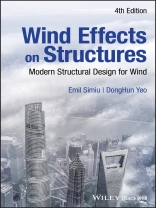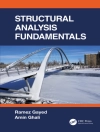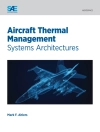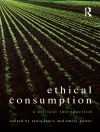Provides structural engineers with the knowledge and practical tools needed to perform structural designs for wind that incorporate major technological, conceptual, analytical and computational advances achieved in the last two decades.
With clear explanations and documentation of the concepts, methods, algorithms, and software available for accounting for wind loads in structural design, it also describes the wind engineer’s contributions in sufficient detail that they can be effectively scrutinized by the structural engineer in charge of the design.
Wind Effects on Structures: Modern Structural Design for Wind, 4th Edition is organized in four sections. The first covers atmospheric flows, extreme wind speeds, and bluff body aerodynamics. The second examines the design of buildings, and includes chapters on aerodynamic loads; dynamic and effective wind-induced loads; wind effects with specified MRIs; low-rise buildings; tall buildings; and more. The third part is devoted to aeroelastic effects, and covers both fundamentals and applications. The last part considers other structures and special topics such as trussed frameworks; offshore structures; and tornado effects.
Offering readers the knowledge and practical tools needed to develop structural designs for wind loadings, this book:
* Points out significant limitations in the design of buildings based on such techniques as the high-frequency force balance
* Discusses powerful algorithms, tools, and software needed for the effective design for wind, and provides numerous examples of application
* Discusses techniques applicable to structures other than buildings, including stacks and suspended-span bridges
* Features several appendices on Elements of Probability and Statistics; Peaks-over-Threshold Poisson-Process Procedure for Estimating Peaks; estimates of the WTC Towers’ Response to Wind and their shortcomings; and more
Wind Effects on Structures: Modern Structural Design for Wind, 4th Edition is an excellent text for structural engineers, wind engineers, and structural engineering students and faculty.
表中的内容
Preface to the Fourth Edition xix
Introduction xxi
Part I Atmospheric Flows, Extreme Wind Speeds, Bluff Body Aerodynamics 1
1 Atmospheric Circulations 3
2 The Atmospheric Boundary Layer 17
3 Extreme Wind Speeds 55
4 Bluff Body Aerodynamics 73
5 Aerodynamic Testing 105
6 Computational Wind Engineering 135
7 Uncertainties in Wind Engineering Data 157
Part II Design of Buildings 167
8 Structural Design for Wind 169
9 Stiffness Matrices, Second-Order Effects, and Influence Coefficients 179
10 Aerodynamic Loads 183
11 Dynamic and Effective Wind-Induced Loads 195
12 Wind Load Factors and Design Mean Recurrence Intervals 203
13 Wind Effects with Specified MRIs: DCIs, Inter-Story Drift, and Accelerations 211
14 Equivalent Static Wind Loads 219
15 Wind-Induced Discomfort in and Around Buildings 225
16 Mitigation of Building Motions 251
17 Rigid Portal Frames 259
18 Tall Buildings 267
Part III Aeroelastic Effects 283
19 Vortex-Induced Vibrations 287
20 Galloping and Torsional Divergence 297
21 Flutter 305
22 Slender Chimneys and Towers 315
23 Suspended-Span Bridges 331
Part IV Other Structures and Special Topics 347
24 Trussed Frameworks and Plate Girders 349
25 Offshore Structures 367
26 Tensile Membrane Structures 385
27 Tornado Wind and Atmospheric Pressure Change Effects 389
28 Tornado- and Hurricane-Borne Missile Speeds 399
Appendices 409
Appendix A Elements of Probability and Statistics 411
A.1 Introduction 411
A.2 Fundamental Relations 412
A.3 Random Variables and Probability Distributions 415
A.4 Descriptors of Random Variable Behavior 419
A.5 Geometric, Poisson, Normal, and Lognormal Distributions 420
A.6 Extreme Value Distributions 422
A.7 Statistical Estimates 425
A.8 Monte Carlo Methods 427
A.9 Non-Parametric Statistical Estimates 428
Appendix B Random Processes 433
B.1 Fourier Series and Fourier Integrals 433
B.2 Parseval’s Equality 435
B.3 Spectral Density Function of a Random Stationary Signal 435
B.4 Autocorrelation Function of a Random Stationary Signal 437
B.5 Cross-Covariance Function, Co-Spectrum, Quadrature Spectrum, Coherence 438
B.6 Mean Upcrossing and Outcrossing Rate for a Gaussian Process 439
B.7 Probability Distribution of the Peak Value of a Random Signal with Gaussian Marginal Distribution 441
Appendix C Peaks-Over-Threshold Poisson-Process Procedure for Estimating Peaks 443
C.1 Introduction 443
C.2 Peak Estimation by Peaks-Over-Threshold Poisson-Process Procedure 444
C.3 Dependence of Peak Estimates by BLUE Upon Number of Partitions 451
C.4 Summary 451
Appendix D Structural Dynamics 455
D.1 Introduction 455
D.2 The Single-Degree-of-Freedom Linear System 455
D.3 Continuously Distributed Linear Systems 458
D.4 Example: Along-Wind Response 463
Appendix E Structural Reliability 467
E.1 Introduction 467
E.2 The Basic Problem of Structural Safety 468
E.3 First-Order Second-Moment Approach: Load and Resistance Factors 469
E.4 Structural Strength Reserve 475
E.5 Design Criteria for Multi-Hazard Regions 477
Appendix F World Trade Center Response to Wind 481
F.1 Overview 481
F.2 NIST-Supplied Documents 482
F.3 Discussion and Comments 482
Index 487
关于作者
Emil Simiu, Ph D (Princeton Univ.) is a registered professional engineer in the states of New York and New Jersey, and a NIST Fellow in the National Windstorm Impact Reduction Program, National Institute of Standards and Technology (NIST). He served as senior structural engineer with Ammann and Whitney Inc., New York, and Severud & Assoc., New York; consultant with the U.S. Nuclear Regulatory Commission, the World Bank, and Zetlin-Argo, a forensic engineering firm; and distinguished research professor and professor of practice at Florida International University. He is a Fellow of the American Society of Civil Engineers and served as Chair of the ASCE Committees on Wind Effects, Dynamic Effects, and the Reliability of Offshore Structures. He is the recipient of numerous awards, including the 2006 Japan Association for Wind Engineering Prize for the outstanding wind engineering publication of the year, and the U.S. Federal Engineer of the Year award from the National Society of Professional Engineers.
Dong Hun Yeo, Ph D (Univ. of Illinois) is a registered professional engineer in the state of Virginia, and a research structural engineer in the National Windstorm Impact Reduction Program, National Institute of Standards and Technology (NIST). He served as a structural engineer with Hyundai Construction and Engineering Company. He teaches Wind Engineering in the Engineering Professionals program, Johns Hopkins University, where he also taught Structural Dynamics. He is a member of the American Society of Civil Engineers, the ASCE 7 Standard Subcommittee on Wind Loads, the ASCE 49 Standard Committee on Wind Tunnel Testing for Buildings and Other Structures, the ASCE Technical Subcommittee on Computer-Aided Wind Engineering, the ASCE Subcommittee on the Design of Non-Residential Structures Subject to Tornadoes, and the ASCE Committee on Fluid Dynamics.












